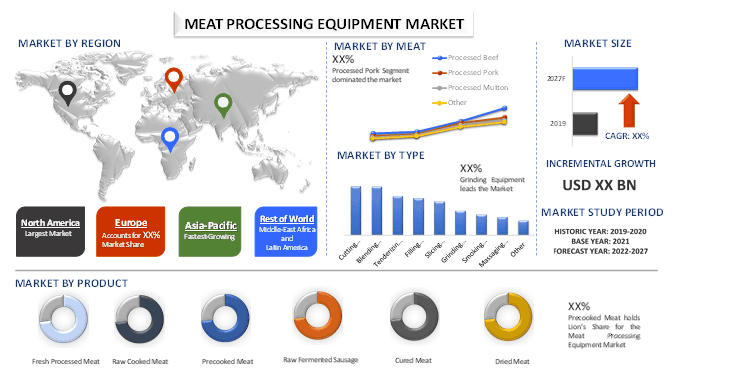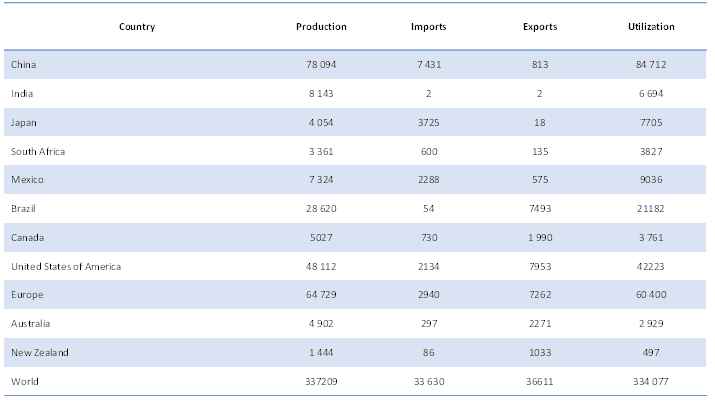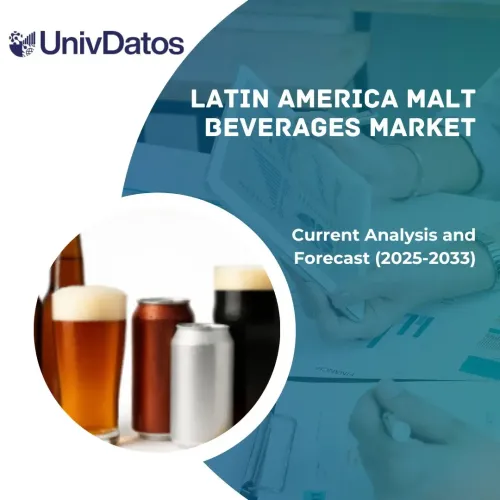- Home
- About Us
- Industry
- Services
- Reading
- Contact Us
Meat Processing Equipment Market: Current Analysis and Forecast (2021-2027)
Emphasis on Product (Fresh Processed Meat, Raw Cooked Meat, Precooked Meat, Raw Fermented Sausage, Cured Meat, Dried); Meat (Processed Beef, Processed Pork, Processed Mutton, Other); Type (Cutting Equipment, Blending Equipment, Tenderizing Equipment, Filling Equipment, Slicing Equipment, Grinding Equipment, Smoking Equipment, Massaging Equipment, Other); Region/Country
The global meat processing equipment market is valued at around $6.0 billion in 2020 and is likely to showcase a CAGR of ~5.5% during the forecast period (2021-2027). Meat processing equipment is a type of food processing equipment used to process meat to enhance its taste and shelf life. Rising investments in the automation of Meat Processing Equipment machinery in countries, such as Japan, India, the U.K., Germany, and the U.S., are likely to spur the demand for Meat Processing Equipment equipment. For instance, in November 2019, Marel opened its new production center in Dongen, Netherlands, because the former location in Dongen no longer met contemporary standards. Therefore, the realization of the new product center was an initiative taken by the company to improve its efficiency.
World total meat exports reached 38.7 million tonnes, up 5.7 percent from 2019, albeit slower than the 7.4 percent growth registered in 2019. Asia’s imports expanded by 15.8 percent to over 22 million tones, accounting for 63 percent of global meat imports, principally driven by the continued ASF impacts on East Asia’s pig meat production. Induced by the deficit, meat imports by China rose by 57.6 percent, to 11.7 million tones, with pig and poultry meats rising the most. Furthermore, the increased meat production has been boosting the market for Meat Processing Equipment equipment. The total meat production is estimated at 337.2 million tones (in carcass weight equivalent) in 2020, like the previous year, as increased poultry and ovine meat outputs compensated for pig and bovine meat production contractions. In the pig meat sector, although African swine fever continued to adversely impact production in East Asia, mainly China, the Philippines and Viet Nam, the sector made a faster recovery than had been anticipated. Bovine meat output declines were widespread with reductions in all major geographical regions.
Furthermore, the increased meat production has been boosting the market for Meat Processing Equipment equipment. The total meat production is estimated at 337.2 million tones (in carcass weight equivalent) in 2020, like the previous year, as increased poultry and ovine meat outputs compensated for pig and bovine meat production contractions. In the pig meat sector, although African swine fever continued to adversely impact production in East Asia, mainly China, the Philippines and Viet Nam, the sector made a faster recovery than had been anticipated. Bovine meat output declines were widespread with reductions in all major geographical regions.
Total meat statistics (thousand tonnes – carcass weight equivalent), 2019

GEA Group Aktiengesellschaft, The Middleby Corporation, Heat and Control, Inc, Marel, Key Technology, Inc, JBT Corporation, Illinois Tool Works Inc. (ITW), Bettcher Industries, Inc, Welbilt, Mepaco Group are some of the prominent players operating in the global Meat Processing Equipment market. Several M&A’s along with partnerships have been undertaken by these players to facilitate customers with hi-tech and innovative products.
Insights Presented in the Report
“Amongst precooked meat, countertop segment holds the major share”
Based on product, the global meat processing equipment market is segmented into fresh processed meat, raw cooked meat, precooked meat, raw fermented sausage, cured meat, and dried. The precooked meat segment dominated the market in 2020 and is expected to maintain its dominance during the forecast period. As these products utilize a variety of meat parts, various products are offered in this category. This is the key factor driving the market for precooked meat, which, in turn, boosts the precooked meat equipment market.
“Amongst meat, processed pork is anticipated to grow at the highest CAGR during the analyzed period”
Further based on meat, the market is divided into processed beef, processed pork, processed mutton, and other. In 2020, processed pork accounted for a maximum revenue share and is expected to remain dominant during the analyzed period owing to its easy availability. The primary reason for the high demand for pork, despite the religious restriction on its consumption in various parts of the world, is that pork is free of Bovine Spongiform Encephalopathy (BSE) or mad cow disease, which lowers the protein quality in the meat.
“Amongst type, grinding equipment is anticipated to grow at the highest CAGR during the analyzed period”
Further type on product, the market is fragmented into cutting equipment, blending equipment, tenderizing equipment, filling equipment, slicing equipment, grinding equipment, smoking equipment, massaging equipment, and other. In 2020, grinding equipment accounted for a maximum market revenue share and is expected to remain dominant during the analyzed period owing to the increasing consumption of meat products has also been boosting the demand for Meat Processing Equipment in the food industry. For instance, Americans consume an average of 2.4 burgers per day according to the USDA, which is about 50 billion burgers per year.
“North America signifies one of the largest markets of Meat Processing Equipment Market”
For a better understanding of the market dynamics of the Meat Processing Equipment market, a detailed analysis was conducted for different regions across the globe including North America (United States, Canada, and the Rest of North America), Europe (Germany, France, Italy, Spain, United Kingdom and Rest of Europe), Asia-Pacific (China, Japan, India, Australia, and Rest of APAC), Rest of World has been conducted. North America held the considerable market share in 2020. The market in North America is driven by the rising demand for processed meat, the growing investment in Meat Processing Equipment facilities, and the presence of a large number of meat processors, such as Tyson Foods, Cargill Meat Solutions Corp., and JBS USA in this region.
Reasons to buy this report:
- The study includes market sizing and forecasting analysis validated by authenticated key industry experts
- The report presents a quick review of overall industry performance at one glance
- The report covers an in-depth analysis of prominent industry peers with a primary focus on key business financials, product portfolio, expansion strategies, and recent developments
- Detailed examination of drivers, restraints, key trends, and opportunities prevailing in the industry
- The study comprehensively covers the market across different segments
- Deep dive regional level analysis of the industry
Customization Options:
The Meat Processing Equipment Market can further be customized as per the requirement or any other market segment. Besides this, UMI understands that you may have your own business needs, hence feel free to connect with us to get a report that completely suits your requirements.
Table of Content
Analyzing the historical market, estimation of the current market, and forecasting the future market of the Global Meat Processing Equipment Market were the three major steps undertaken to create and analyze the adoption of Meat Processing Equipment due to increased demand for recycled products. Exhaustive secondary research was conducted to collect the historical market numbers and estimate the current market size. Secondly, to validate these insights, numerous findings and assumptions were taken into consideration. Moreover, exhaustive primary interviews were also conducted, with industry experts across the value chain of the Meat Processing Equipment sector. Post assumption and validation of market numbers through primary interviews, we employed a top-down/bottom-up approach to forecast the complete market size. Thereafter, market breakdown and data triangulation methods were adopted to estimate and analyze the market size of segments and sub-segments the industry pertains to. Detailed methodology is explained below:
Analysis of Historical Market Size
Step 1: In-Depth Study of Secondary Sources:
Detailed secondary study was conducted to obtain the historical market size of the Meat Processing Equipment through company internal sources such as annual report & financial statements, performance presentations, press releases, etc., and external sources including journals, news & articles, government publications, competitor publications, sector reports, third-party database, and other credible publications.
Step 2: Market Segmentation:
After obtaining the historical market size of the Meat Processing Equipment market, we conducted a detailed secondary analysis to gather historical market insights and share for different segments for major regions. Major segments included in the report are technology and application. Further country-level analyses were conducted to evaluate the overall adoption of Meat Processing Equipment in every region.
Step 3: Factor Analysis:
After acquiring the historical market size of different segments and sub-segments, we conducted a detailed factor analysis to estimate the current market size of Meat Processing Equipment. Further, we conducted factor analysis using dependent and independent variables such as increasing demand for healthy diet and the growing population. A thorough analysis was conducted for demand and supply-side scenarios considering top partnerships, merger and acquisition, business expansion, and product launches in the Meat Processing Equipment industry across the globe.
Current Market Size Estimate & Forecast
Current Market Sizing: Based on actionable insights from the above 3 steps, we arrived at the current market size, key players in the Meat Processing Equipment market, and market shares of the segments. All the required percentage shares split, and market breakdowns were determined using the above-mentioned secondary approach and were verified through primary interviews.
Estimation & Forecasting: For market estimation and forecast, weights were assigned to different factors including drivers & trends, restraints, and opportunities available for the stakeholders. After analyzing these factors, relevant forecasting techniques i.e., top-down/bottom-up approach was applied to arrive at the market forecast about 2027 for different segments and subsegments across the major markets globally. The research methodology adopted to estimate the market size encompasses:
- The industry’s market size, in terms of value (USD) and the adoption rate of Meat Processing Equipment across the major markets domestically
- All percentage shares, splits, and breakdowns of market segments and sub-segments
- Key players in the Meat Processing Equipment market in terms of services offered. Also, the growth strategies adopted by these players to compete in the fast-growing market
Market Size and Share Validation
Primary Research: In-depth interviews were conducted with the Key Opinion Leaders (KOLs) including Top Level Executives (CXO/VPs, Sales Head, Marketing Head, Operational Head, and Regional Head, Country Head, etc.) across major regions. Primary research findings were then summarized, and statistical analysis was performed to prove the stated hypothesis. Inputs from primary research were consolidated with secondary findings, hence turning information into actionable insights.
Split of Primary Participants in Different Regions
Market Engineering
Data triangulation technique was employed to complete the overall market estimation and to arrive at precise statistical numbers of each segment and sub-segment of the Meat Processing Equipment market. Data was split into several segments & sub-segments post studying various parameters and trends in the areas of the technology and application end-user of the Meat Processing Equipment market.
Main Objective of the Meat Processing Equipment Market Study
The current & future market trends of Meat Processing Equipment were pinpointed in the study. Investors can gain strategic insights to base their discretion for investments from the qualitative and quantitative analysis performed in the study. Current and future market trends were determined the overall attractiveness of the market at a regional level, providing a platform for the industrial participant to exploit the untapped market to benefit as a first-mover advantage. Other quantitative goals of the studies include:
- Analyze the current and forecast market size of Meat Processing Equipment in terms of value (USD). Also, analyze the current and forecast market size of different segments and sub-segments
- Segments in the study include areas of type, meat and product
- Define and analysis of the regulatory framework for the Meat Processing Equipment industry
- Analyze the value chain involved with the presence of various intermediaries, along with analyzing customer and competitor behaviors of the industry
- Analyze the current and forecast market size of the Meat Processing Equipment market for the major region
- Major regions studied in the report include North America (the United States, and Canada), Europe (Germany, France, Italy, Spain, and United Kingdom), Asia-Pacific (China, Japan, India, and Australia), and Rest of the World
- Company profiles of the Meat Processing Equipment market and the growth strategies adopted by the market players to sustain in the fast-growing market
Deep dive regional level analysis of the industry
Related Reports
Customers who bought this item also bought










